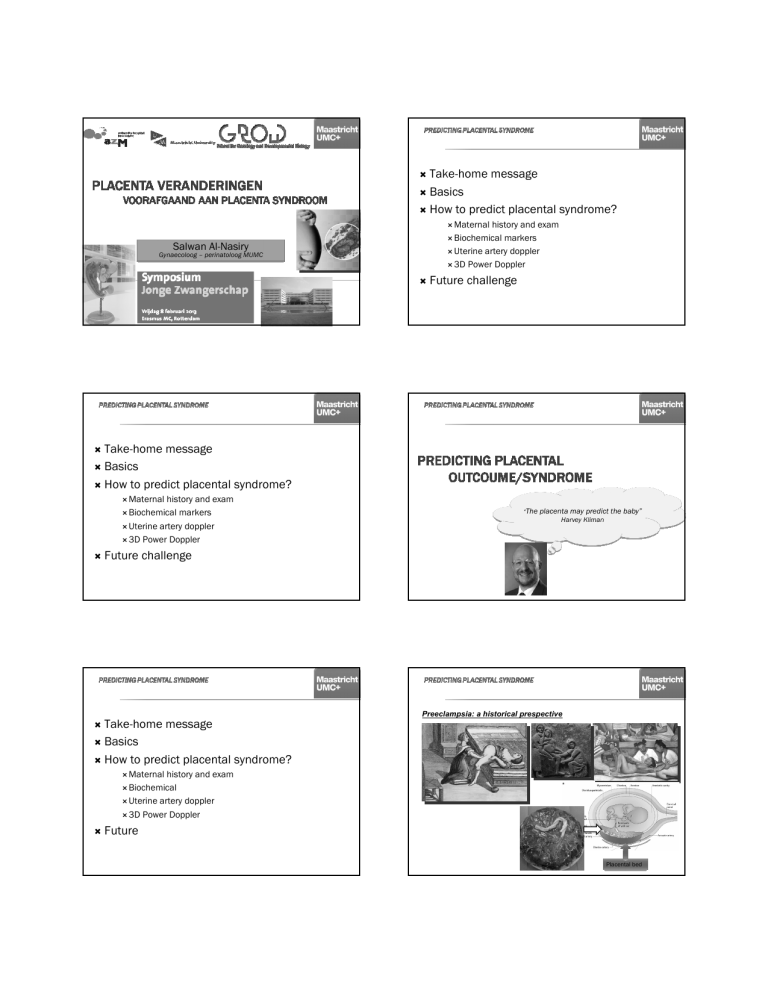
Take-home message
Basics
How to predict placental syndrome?
Maternal
history and exam
markers
Uterine artery doppler
3D Power Doppler
Biochemical
Salwan Al-Nasiry
Gynaecoloog – perinatoloog MUMC
Future challenge
Take-home message
Basics
How to predict placental syndrome?
Maternal
history and exam
markers
Uterine artery doppler
3D Power Doppler
Biochemical
“The
placenta may predict the baby”
Harvey Kliman
Future challenge
Preeclampsia: a historical prespective
Take-home message
Basics
How to predict placental syndrome?
Maternal
history and exam
Biochemical
Uterine
3D
artery doppler
Power Doppler
Future
Placental bed
Preeclampsia: defective spiral artery remodelling
Take-home message
Basics
How to predict placental syndrome?
Maternal
history and exam
markers
Uterine artery doppler
3D Power Doppler
Biochemical
Normal
pregnancy
Future
preeclampsia
pathophysiology of preeclampsia
defective spiral
artery remodelling
genetic
? hypoxia
release of placental factors
? trophoblast
microparticles
?ROS/Cytokines
?angiogenic factors
Endothelial dysfunction
Clinical preeclampsia
immune
environment
marker
1st
trim
2nd
trim
Manifest In combi w
PE
Also in…
in…
s.flt-1
--
sEng, PlGF, VEGF,
US
sEng
--
Sflt-1, PlGF, US
IUGR, SGA, HELLP
PlGF
sEng, sflt-1
SGA
PP-13
US
IUGR, preterm
P-Selectin
sflt-1, Activin-A
cf-fetal DNA
Inhibin-A
cf-DNA
--
--
ADAM12
--
--
PTX-3
IUGR
PAPP-A
Birth wt
Tris21, IUGR,
preterm
Tris21/18, SGA
Grill et al. Reproductive Biology and Endocrinology 2009, 7:70
Cell-free fetal DNA
Cell-free fetal DNA
Uterine artery Dopplers
Uterine A. Dopplers 10-14 wk
N= 1067
unilateral notch 23%
bilateral notch 10
5.5
Dugoff et al. American Journal of Obstetrics and Gynecology (2005) 193, 1208–12
Prospectieve cohort
Test
High-risk pregnancy for placental
insufficiency (medical/Obs Hx)
N= 61, all had screening at:
•11-14 wk
•Serum: PAPP-A
•Ut A doppler
•Placental structure
•18-24 wk
•Serum: hCG+AFP
•Ut A doppler
•Placental structure
Costa et al. Placenta 29 (2008) 1034–1040
# Adverse
outcomes
test
abnormal
(total)
# Adverse P value LR+ (95% CI)
outcomes
test
normal
(total)
LRLR- (95% CI)
Ut A Doppler PI
6 (16)
5 (41)
0.057
3.1 (1.1–8.3)
0.71(0.51–0.97)
Placental morphology
5(11)
6 (47)
0.025
3.6 (1.3–8.5)
0.63 (0.36–0.93)
Biochemistry
4 (9)
6 (44)
0.053
3.3 (1.1–7.9)
0.64 (0.34–0.98)
≥1 abnormal tests
9 (24)
2 (34)
0.005
5.9 (1.6–24)
0.68 (0.59–0.89)
≥2 abnormal tests
4 (8)
7 (50)
0.035
3.6 (1.3–7.7)
0.58 (0.27–0.94)
All abnormal tests
2 (3)
9 (55)
0.089
4.1 (1.1–6.3)
0.40 (0.07–0.97)
Costa et al. Placenta 29 (2008) 1034–1040
Placental 3D Power Doppler
Systematic review, total 79’547 patients
• PE
74 studies
• IUGR 61 studies
Results
• Dopplers in 2nd trimester performed better than
1st trimester
• Most Doppler indices had poor predictive
characteristics, depending on:
• patient risk
• outcome severity.
• high PI with notching was the best predictor of:
• pre-eclampsia High risk LR+ 21.0
low risk LR+ 7.5
• IUGR
overall LR+ 9.1
severe LR+ 14.6
Cnossen et al. CMAJ 2008;178(6):701-11
Placental 3D Power
Doppler
Gebb et al. Best Practice & Research Clinical Obstetrics and Gynaecology 25 (2011) 355–366
Gudmundsson et al. Semin Perinatol 33:270-280, 2009
Odibo et al. Placenta 32 (2011) 230e234
Abnormal placental structure (placenta lakes)
Take-home message
Basics
How to predict placental syndrome?
Maternal
history and exam
Biochemical
Doppler
Placental
structure
Future challenge
Abnormal placental structure (placenta lakes)
Abnormal placental structure (placenta lakes)
Routine 20-wk scan
N= 109 met placenta lakes (8.7% van
de populatie), groepen:
•I = klein, verdwijnt later
= 52
•II = groot, verdwijnt later
= 19
•III = klein, persisteert
= 27
•IV = groot persistereert
= 11
Huwang et al. European Journal of Obstetrics & Gynecology and Reproductive Biology 162 (2012) 139–143
37-42wk geplande
sectio of inleiding
Onderzoekers:
G. Gruiskens
C. Ghousein
Begeleiders:
K. vdVijver (patho)
M. Baldewijn (patho)
S. Al-Nasiry (gyn)
M. Spaanderman (gyn)
Huwang et al. European Journal of Obstetrics & Gynecology and Reproductive Biology 162 (2012) 139–143
2
22-37wk, prospectief
cohort, placental lakes
Klinische uitkomsten
(moeder, kind)
Onderzoekers:
G. Gruiskens
C. Ghousein
Begeleiders:
K. vdVijver (patho)
M. Baldewijn (patho)
S. Al-Nasiry (gyn)
M. Spaanderman (gyn)
Acute atherosis
Onderzoeker:
D. Stevens
Long term outcome
(repeat preeclampsia,
CV risk profile)
Begeleiders:
H. Bulten(patho)
J. vd Vugt (gyn)
S. Al-Nasiry (gyn)
M. Spaanderman (gyn)
Stevens et al. 2011
Stevens et al. 2011
Clinical parameters
Diastolic blood
pressurea
Urine protein-tocreatinine ratioa
Thrombocytesb
LDHa
ASATa
ALATa
Gestational age
Birthweight (grams)
Birthweight (centile)
APGAR 1 minute
APGAR 5 minute
Umbilical artery pH
DV
113
Histological
parameters
Placenta Weight (gram)
Infarction degreea
Infarction locationb
Calcificatins degreea
Hematoma degreea
Ischemia degreea
Controls
108
p-values
0.027
5.3
4.4
0.368
135
803
140
132
30w6d
1176
11.5
5,5
6,9
7.18
120
915
243
211
32w5d
1645
18.4
6
7,8
7.25
0.409
0.232
0.151
0.332
0.030
0.030
0.273
0.428
0.124
0.012
DV
Controls
p-values
229
1
1.4
0,3
0,5
1,7
268
0,9
1.3
0,1
0,1
1,5
0.186
0.546
0.726
0.051
0.038
0.213
Stevens et al. Placenta 33 (2012) 630e633
final thoughts…
“The
placenta may predict the baby”
Harvey Kliman
Stevens et al. unpublished
